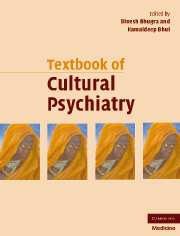Book contents
- Frontmatter
- Contents
- Contributors
- Foreword
- Preface
- Part I Theoretical background
- Part II Culture and mental health
- Part III Culture and mental disorders
- 15 Neurosis
- 16 Schizophrenia and related psychoses
- 17 Affective disorders
- 18 Substance misuse
- 19 Culture and mental disorders: suicidal behaviour
- 20 Personality disorders and culture
- 21 Culture and obsessive-compulsive disorder
- 22 Culture and eating disorders
- 23 Childhood and adolescent psychiatric disorders
- 24 Culture and schizophrenia
- 25 Disorders of ageing across cultures
- Part IV Theoretical aspects of management
- Part V Management with special groups
- Part VI Cultural research and training
- Cultural psychiatry: the past and the future
- Index
- References
19 - Culture and mental disorders: suicidal behaviour
from Part III - Culture and mental disorders
Published online by Cambridge University Press: 11 August 2009
- Frontmatter
- Contents
- Contributors
- Foreword
- Preface
- Part I Theoretical background
- Part II Culture and mental health
- Part III Culture and mental disorders
- 15 Neurosis
- 16 Schizophrenia and related psychoses
- 17 Affective disorders
- 18 Substance misuse
- 19 Culture and mental disorders: suicidal behaviour
- 20 Personality disorders and culture
- 21 Culture and obsessive-compulsive disorder
- 22 Culture and eating disorders
- 23 Childhood and adolescent psychiatric disorders
- 24 Culture and schizophrenia
- 25 Disorders of ageing across cultures
- Part IV Theoretical aspects of management
- Part V Management with special groups
- Part VI Cultural research and training
- Cultural psychiatry: the past and the future
- Index
- References
Summary
EDITORS' INTRODUCTION
Suicidal behaviour is one of the common behaviours that is influenced by cultural attitudes to death and self-harm. Rates of suicide vary dramatically across cultures. Even within migrant populations rates of self-harm vary. Thus biological factors alone cannot explain this huge variation. In societies and cultures where suicidal behaviour still remains an illegal act, it is impossible to collect accurate information on epidemiological and aetiological factors. Religion itself and attitudes to suicide within each religion also play a significant role in discouraging self-harm.
In this chapter by Fortune and Hawton the focus is beyond Europe and the West. With clear definitions and epidemiological exploration of the existing data, the authors discuss the differential rates of suicide across cultures and deliberate self-harm among different ethnic groups. Amongst other varying patterns of possible causation and explanations for their act, the ethnic minority groups tend to express less regret compared with their White counterparts. Elevated rates of suicide have been reported in migrants, especially in women originating from the Indian subcontinent. A striking observation is that they also used more violent and dramatic methods to commit suicide, such as burning and hanging. The rates of suicide and deliberate self-harm are lower in men of South Asian and Caribbean ancestry. Interestingly, findings are beginning to emerge that the newly expanding economies of Kazakhstan and Ukraine are beginning to report an increase in rates. Rapid industrialization and urbanization may change the social networks and systems and perhaps also increase substance abuse. The interesting paradox highlighted by the authors is that the traditionally low reported rates of suicide in Black males in the USA increased between 1980 and 1995.
- Type
- Chapter
- Information
- Textbook of Cultural Psychiatry , pp. 255 - 271Publisher: Cambridge University PressPrint publication year: 2007
References
- 3
- Cited by



